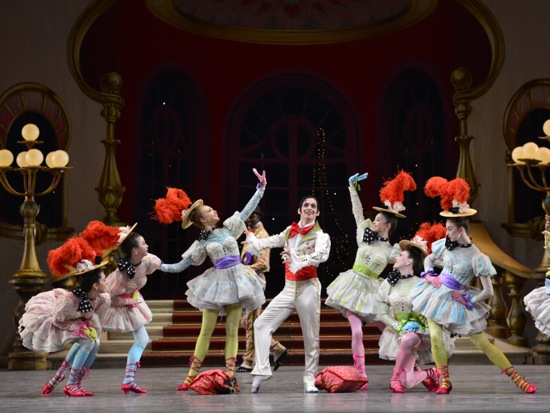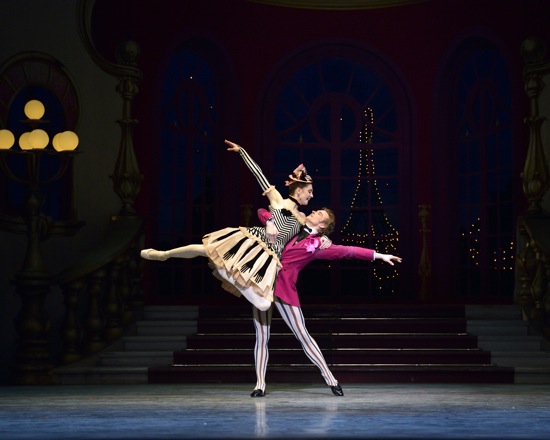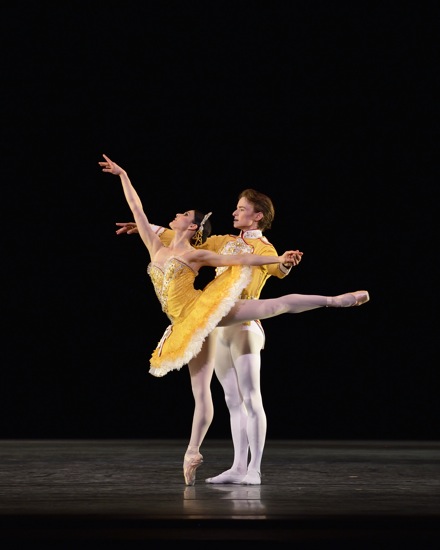ABT’s spring season at the Met offers two Balanchine ballets and one by Massine.
In November, 1947, just before a small, stylish company named Ballet Society became the New York City Ballet, its balletmaster, George Balanchine, bestowed a gift on another New York-based company, Ballet Theatre. Theme and Variations, set to the “Theme and Variations” movement from Tchaikovsky’s Suite No. 3 for Orchestra,wasn’t technically a gift, of course (Balanchine was certainly paid), but on and off over the years, it has been a jewel in American Ballet Theatre’s repertory—offering 19th-century elegance with steps demanding 20th-century virtuosity. Aficionados can have fun debating ABT’s production versus NYCB’s own (usually seen as the last movement of Suite No. 3).
ABT has given Theme and Variations various facelifts. The costumes by Zack Brown—new this season— are similar in color scheme to those that Gelsey Kirkland, Mikhail Baryshnikov, and the corps de ballet wore in the late 1970s. The tutus for the eight corps de ballet women are tomato red, the four demi-soloists are garbed in peach, and the principal couple shines in gold. This means that in the variation that has each demi-soloist anchoring two women who twine around her in decorously lovely ways, you see her as, say, the pale center of a fluttering red blossom. In an earlier production, all twelve women were identical in lavender, and the contrast was muted.
Balanchine created ingenious variations on his theme that tug gently against 19th-century classicism. Of course, the women in red often split the stage to work in inkblot symmetry. However, when they, neatly lined up at the back, show that they’ve been paying attention and can execute the step-point, step-point theme that the principal couple has initiated, the demi-soloists in front of them move into counterpoint.
The choreography often hews to the traditional belief that if a step is worth doing, it’s worth doing again. And again. And maybe a couple more times. So reassuring in a ballet that suggests the Tsarist court’s hierarchy and manners. But Balanchine’s steps are worth seeing more than once. So are such designs as the eight corps women hand-in-hand, creating garlands around the ballerina while supporting her—as if she, unfurling her legs this way and that, were the single blossom on a well-trained vine. And who wouldn’t love the suddenness with which cavaliers make their first appearance just in time for the last dance? Lord knows where they’ve been, but they heard a polonaise striking up and couldn’t stay away.
The corps de ballet and soloists performed beautifully and with precision. The principal dancers at the May 21st matinee were Sarah Lane and Danil Simkin (replacing Herman Cornejo, who is injured). Lane is a charming, spirited dancer, strong and accurate without being dry, although sometimes she didn’t seem entirely into the celebratory nature of the occasion or her partner. We’re use to thinking of Simkin as a Puckish dancer—a fine jumper with an elfin air. In Theme and Variations, he has to become a prince, which he does with taste and conviction. However, although he dances with impeccable technique, he doesn’t yet seem fully at ease in the role. Sober, almost militarily erect, his chest puffed out a bit in his elegant jacket, he’s appropriately careful with his partner, but doesn’t seem to be enjoying this party.
This season, ABT has paired Theme and Variations with Balanchine’s 1972 Duo Concertant—a very different sort of ballet. The formality involved isn’t aloof decorum, just fine manners. The two dancers, wearing black and white practice attire, stand by the onstage grand piano and listen while the pianist and violinist play the first section of Stravinsky’s plangent music, and they return to those places when not called on to dance.
The choreography, like the music, diverges from conventional harmonies—exploring jaggedness, sharpness, off-balance steps, and, at times, a certain sportiness. At the performance I attended, the music was admirably played by pianist Emily Wong and violinist Benjamin Bowman, and the dancers were Paloma Herrera and James Whiteside. Watching them, I wondered whether ABT dancers have been advised that to perform Balanchine ballets, they have to remain neutral and simply execute the movement as musically as possibly. Certainly Herrera and Whiteside look and perform excellently together, despite their differences. Her dancing has a warmth and an amplitude; although she’s never off the beat, she gives the impression of dancing slowly to try to fill out the steps. Whiteside, on the other hand, is very correct in his behavior, almost stern—executing the steps extremely well, but without ease (there’s that word again).

Craig Salstein as The Peruvian surrounded by the “Cocodettes” in Leonide Massine’s Gaîté Parisienne. Photo: Gene Schiavone
You could not accuse anyone in the cast of Gaîté Parisienne of being uptight. This 1938 ballet by Leonide Massine is a romp, and the company enters it with gusto. Performed to infectious music drawn from various operas by Jacques Offenbach (arranged by Manuel Rosenthal), the ballet takes place in an extremely popular Parisian nightspot of the Belle Epoque. Through its doors come members of the nobility, dandies, cocodettes (usually defined as high-born women with the morals of prostitutes), a regiment of soldiers, a visitor from Peru, and a squad of can-can dancers. There is a plot of sorts amid the high-spirited fraternizing and flirting. “She’s mine!” “I saw her first!” is, roughly speaking the contention that sets off mayhem, but by closing time and the lulling “Barcarolle” from The Tales of Hoffmann, everyone is able to leave with the destined partner.
As staged by Massine’s son, choreographer Lorca Massine (assisted by Susan Jones), the ballet utilizes the outrageous costumes that Christian Lacroix designed for the 1988 revival. Outrageous as absurd, for instance, in the towering red ostrich plumes on the cocodettes’ hats, and outrageous as over-the-top imaginative, as in the gaudy, individualized mélanges of stripes, polka-dots, ruffles, and bright colors in the can-can girls’ oufits.
Perhaps it’s best that I make a confession: Gaîté Parisienne was one of the first ballets I ever saw. I was 12 years old or so when the Ballet Russe de Monte Carlo played my Los Angeles hometown, and I thought the work was a marvel—funny, colorful, and heart-stoppingly romantic. That remembered thrill still clings fitfully to it when I see it decades later, despite whatever flaws my critical adult eyes may acknowledge.
You know what you’re in for as soon as the curtain goes up on Zach Brown’s inviting set, and you see perky, pink-stockinged maids scrubbing the floor in time to the music and waiters flourishing white napkins as they jump into the air. There are four of each sex—perfect for canoodling and getting in a bit of polka-ing. “Ooh-la-la!” say the men’s gestures. Massine often elicits comedy via brief stiff poses, double-takes, and reactions that freeze momentarily. The soldiers who arrive later stab their invisible bayonets and swipe their boots to a polish in unison; when they march toward the door, the women cover their faces to weep in rhythmic accord, and embrace the men when they instantly turn and come back. That about sums up what a war entails, if you leave out the sticky bits.. The choreographer also trots out some venerable jokes: two men accidentally make a misstep and end up in each other’s arms. Horrors!

Veronica Part as The Glove Seller and Jared Matthews as The Baron in Gaîté Parisienne. Photo: Gene Schiavone
The skillful choreography makes an occasional sly allusion to ballet history; instead of The Sleeping Beauty’s “Rose Adagio,” with Princess Aurora moving down a line of four ardent suitors, accepting roses and hitting perfect balances, Massine’s Flower Girl (the effusive, flirty Misty Copeland) dances from man to man, sipping champagne as she passes each and accepting (or was it giving?) single flowers (in early versions of the ballet, entire bouquets figured).
The stage is abuzz with activity. There’s plenty of byplay and background fraternizing behind the lusty patterns. Grant DeLong, Blaine Hoven, and Calvin Royal—who arrive in checkered suits, each arm-in-arm with two cocodettes — appear at one point to be playing billiards, although the table is offstage. In addition to the Flower Girl, the principal players on this promisingly amorous night are The Baron (Jared Matthews), the Glove Seller (Veronica Part), The Peruvian (Craig Salstein), La Lionne (Karen Uphoff), The Duke (Roman Zhurbin), The Officer (Sterling Baca), and the Dance Master (Eric Tamm). And they certainly do get entangled.
The Peruvian— bustling jauntily about, flourishing two suitcases—is a naïve would-be Casanova, agog at his first sight of Parisian nightlife. In this role that Leonide Massine created for himself, Salstein, one of the company’s most versatile and whole-hearted performers, adds a certain oily sensuality to the role without compromising too much of its jauntiness. I do think that he missed one opportunity. In the remarkable film of Gaîté Parisienne that Victor Jessen pieced together over ten years of clandestine recording, Leon Danelian’s Peruvian lets the Glove Seller slip the gloves he’s buying over his held-up hands while he wriggles with barely contained erotic pleasure (http://www.youtube.com/watch?v=pH_H-_j888M). An abridged Hollywood film of Gaité, with Massine as the Peruvian is also online: http://www.youtube.com/watch?v=W1jaWvIfa68.
The Glove Seller and the Baron in Jessen’s record film (and in my first entranced live viewing of the ballet) were played by Alexandra Danilova and Frederic Franklin, and when they danced together to the gorgeous waltz from La Périchole, which escalated in tempo toward the end like an excited heartbeat, they gave the illusion of being rapturously in love. Part and Mathews are excellent dancers, but they are perhaps not sufficiently seasoned in the roles to constantly convey that struck-by-love impression, although he is more ardent than she is. In a sense, his role is undercut by his costume—striped tights and a scarlet frock coat (on the short side), as opposed to the trim military jacket and tight pants of yore. From the thighs up, he looks more like a romantic dreamer by the fireside than an out-and-about fellow.
Few in the audience appeared to share my reservations. Massine was a savvy planner in producing this ballet-bouffe. Tired of waltzing? Bring on the soldiers. The matinee crowd ate everything up—the knock-down fighting, the romancing, the zesty performing, and the sense that in the best of worlds the dancing never stops.

